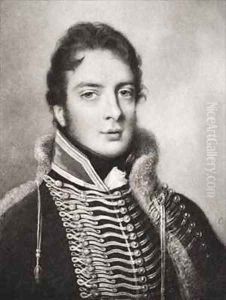Engleheart, John Cox Dillman Paintings
John Cox Dillman Engleheart was an English miniature painter, born in 1782. He was part of a family with a strong artistic lineage, being the nephew of the famous Georgian miniaturist George Engleheart, one of the preeminent portrait miniaturists of his time. This familial connection undoubtedly influenced John's career choice and his development as an artist. Despite the overshadowing fame of his uncle, John Cox Dillman Engleheart established his own reputation in the field of miniature painting during the late 18th and early 19th centuries, a period that is often considered the golden age of miniature portraiture in England.
Engleheart's career spanned several decades, during which he developed a distinctive style characterized by precise detailing, vibrant colors, and a remarkable ability to capture the character and essence of his subjects. His work was highly sought after by the aristocracy and the burgeoning middle class of the time, who desired portable and intimate portraits of themselves and their loved ones. Engleheart exhibited at the Royal Academy, London, from 1801 to 1822, which helped to cement his reputation as a leading miniaturist of his time.
Beyond his artistic achievements, little is documented about Engleheart's personal life, indicating that he may have preferred to remain out of the public eye, allowing his work to speak for itself. He passed away in 1862, leaving behind a legacy that, although not as widely recognized as that of his uncle George, significantly contributed to the rich tradition of miniature painting in England. John Cox Dillman Engleheart's miniatures continue to be appreciated by collectors and art historians for their beauty, technical skill, and the window they offer into the aesthetic sensibilities and social dynamics of his era.
